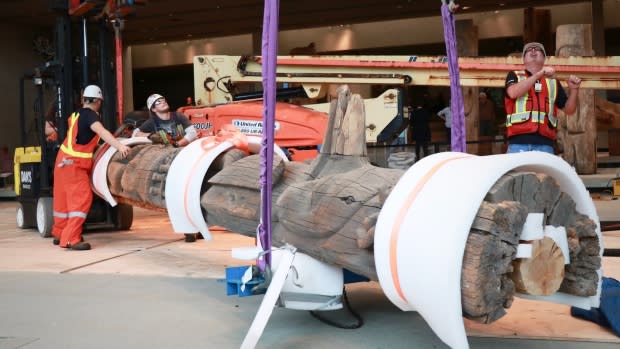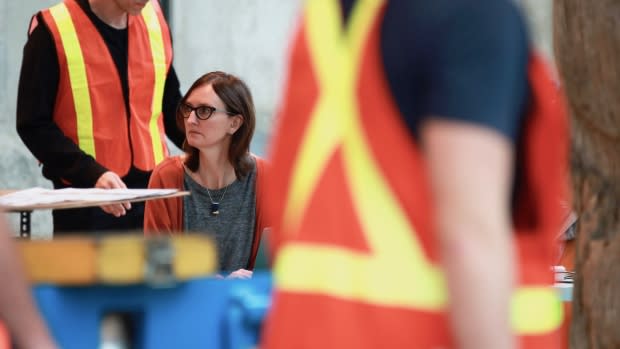Irreplaceable totems moved aside for Museum of Anthropology seismic upgrades
When the huge Gitanyow totem was finally lifted off the ground on Thursday morning, a small pile of rotten wood dust and debris fell to the concrete floor.
The pole took a six-person crew with a forklift and crane inside the Museum of Anthropolgy's (MOA) great hall about an hour to dislodge. The workers carefully wrapped sections in padded foam, and through a combination of delicate care and industrial power, laid the totem sideways onto its back.
The totem, believed to have been carved in the Gitanyow community in the 1870s, is one of about 30 carvings that will have to be removed from the great hall, so seismic upgrades can be carried out.

It tells the history of the Gitanyow wolf clan and was sold to the museum in 1958, years before Arthur Erickson's iconic building was constructed.
According to MOA conservator Heidi Swierenga, in the 1970s, Erickson didn't have the benefit of the seismic engineering architects now have.
"We know a lot more now about how the earth and the building is going to behave during a seismic event, and it's time to bring it up to code," said Swierenga.

The works are precious and have to be treated in a culturally sensitive way. With the tallest pole measuring nearly 14 metres, and many weighing more than a tonne, it's a challenging job.
"Each pole has different physical characteristics. Some are very, very strong, because they were carved recently and they haven't been outside as long as the older pieces," she said, adding that phase one of totem removal will begin with the older pieces.
The newer carvings will be moved as part of phase two in January.

The poles are being moved to an adjacent gallery, where they'll be on display throughout the project — but the totems will be resting on their backs.
"There's no other place where we can actually reinstall them standing up, so it's just seen as a temporary blip in their life, a temporary rest, and then when the work is done, they'll be put back up," said Swierenga.
Karen Duffek, MOA curator of contemporary visual arts and Pacific Northwest, said the museum has a long relationship with the First Nation communities on the coast that are represented in the museums collections, and they've been consulted about relocating the culturally important carvings.

"There isn't Indigenous supervision, but again, when we embark on a project like this, it's with the conversation preceding it that's taken place, so people are aware what's going on and can express any concerns," said Duffek.
She said she hasn't heard any pushback from First Nation communities about the plan, but they'll likely take part in determining how the totems are eventually reinstalled.
It's unclear what the seismic upgrade project will ultimately cost, but $8.8 million is the number being tossed around as it gets underway.
Swierenga said the totems will be out of the great hall until the project is complete, nine to 12 months from now.
Follow Rafferty Baker on Twitter: @raffertybaker

